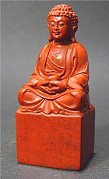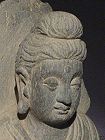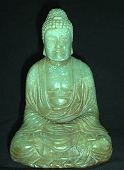When the First Emperor of China ordered his master carver to make his Imperial Seal, he naturally chose jade as the most suitable material for an emperor. As early as 3000 B.C. jade was known in China as yu, the 'royal gem'. In the long history of the art and culture of the enormous Chinese empire, jade has always had a very special significance, roughly comparable with that of gold and diamonds in the West.
 'Jade', or yu, as it is called in China, is strictly speaking a generic term for two different gems, nephrite and jadeite. Jadeite is found in California, Mexico, Japan, Tibet, New Zealand and Burma and is somewhat harder and rarer than nephrite and is therefore regarded as more precious. Nephrite deposits have also been found in China, Russia, Europe and Brazil. Dark green jade, so-called Canada jade, is a nephrite jade found in British Columbia in Western Canada, a leading world producer of this beautiful semi-precious stone.
'Jade', or yu, as it is called in China, is strictly speaking a generic term for two different gems, nephrite and jadeite. Jadeite is found in California, Mexico, Japan, Tibet, New Zealand and Burma and is somewhat harder and rarer than nephrite and is therefore regarded as more precious. Nephrite deposits have also been found in China, Russia, Europe and Brazil. Dark green jade, so-called Canada jade, is a nephrite jade found in British Columbia in Western Canada, a leading world producer of this beautiful semi-precious stone.
But there is another kind of stone which has been just as popular as jade: this is the famous Shoushan or 'Tianhuang' stone, used for carving for 1500 years. There are more than 100 kinds of Shoushan stone, however, yellow Shoushan stone, the color of a loquat, is considered the most valuable, regarded like gold in China. Shoushan stone is quarried from Shoushan, a village in the mountains of China 40 kilometers north of the city of Fuse.
 Shoushan stone carvings have had a long history. Discovered in tombs in southern China, they appear to have been used as sacrificial and religious objects during the Tang (618-907) and Song Dynasties (960-1270). But it is during the Ming Dynasty era (1368-1644) that Shoushan stone carvings became truly famous.
Shoushan stone carvings have had a long history. Discovered in tombs in southern China, they appear to have been used as sacrificial and religious objects during the Tang (618-907) and Song Dynasties (960-1270). But it is during the Ming Dynasty era (1368-1644) that Shoushan stone carvings became truly famous.
As with jade, the carving and cutting of Shoushan stone is carried out with incredible accuracy and artistic finish. Natural markings and color variations in the material are invariably adapted for the cutting of leaves and floral sprays, but no effort is spared to bring out the true character of the object. Shoushan stone has been a popular medium for carving fine statues of the Buddha as well.
As a result of its beauty and rich cultural essence, Shoushan stone has been named "The National Stone of China". Not only are Shoushan stone carving from the Fujian area famous all over the world, many feel that they are also stepping into an unprecedented golden age.
 Natural rock, granite, volcanic and other forms of stone were widely used in ancient times to carve statues of Shakyamuni Buddha. Most of the really large statues throughout Asia are carved from one form of stone or another. Perhaps the most famous and sought after stone carvings of Buddha originate from around the 1st to the 3rd century A.D. These originated from the Ghandara region, the ancient name for the Peshawar Valley and adjoining parts of Pakistan and Afghanistan. Large Ghandaran pieces have sold for hundreds of thousands of dollars at famous auction houses like Sotheby's and Christie's.
Natural rock, granite, volcanic and other forms of stone were widely used in ancient times to carve statues of Shakyamuni Buddha. Most of the really large statues throughout Asia are carved from one form of stone or another. Perhaps the most famous and sought after stone carvings of Buddha originate from around the 1st to the 3rd century A.D. These originated from the Ghandara region, the ancient name for the Peshawar Valley and adjoining parts of Pakistan and Afghanistan. Large Ghandaran pieces have sold for hundreds of thousands of dollars at famous auction houses like Sotheby's and Christie's.
 These Ghandaran pieces are generally either modelled from stucco, a sand/limestone mix, or carved from 'Schist', a metamorphic rock formed by dynamic high-temperature, high-pressure metamorphism that involves a lot of strain. Schists are commonly described in terms of their predominant minerals. The high strain during formation aligns the flat or elongated grains of mica and other minerals into thin layers, or foliation. Because of their great age, many Ghandaran pieces have sustained some damage over the years. It is rare to find pieces of such great antiquity that still retain all their body parts.
These Ghandaran pieces are generally either modelled from stucco, a sand/limestone mix, or carved from 'Schist', a metamorphic rock formed by dynamic high-temperature, high-pressure metamorphism that involves a lot of strain. Schists are commonly described in terms of their predominant minerals. The high strain during formation aligns the flat or elongated grains of mica and other minerals into thin layers, or foliation. Because of their great age, many Ghandaran pieces have sustained some damage over the years. It is rare to find pieces of such great antiquity that still retain all their body parts.
Closeups of the statues on this page and every sculpture in the Villa Del Prado Light of Asia Collection can be found on the main page.

 'Jade', or yu, as it is called in China, is strictly speaking a generic term for two different gems, nephrite and jadeite. Jadeite is found in California, Mexico, Japan, Tibet, New Zealand and Burma and is somewhat harder and rarer than nephrite and is therefore regarded as more precious. Nephrite deposits have also been found in China, Russia, Europe and Brazil. Dark green jade, so-called Canada jade, is a nephrite jade found in British Columbia in Western Canada, a leading world producer of this beautiful semi-precious stone.
'Jade', or yu, as it is called in China, is strictly speaking a generic term for two different gems, nephrite and jadeite. Jadeite is found in California, Mexico, Japan, Tibet, New Zealand and Burma and is somewhat harder and rarer than nephrite and is therefore regarded as more precious. Nephrite deposits have also been found in China, Russia, Europe and Brazil. Dark green jade, so-called Canada jade, is a nephrite jade found in British Columbia in Western Canada, a leading world producer of this beautiful semi-precious stone.
 Shoushan stone carvings have had a long history. Discovered in tombs in southern China, they appear to have been used as sacrificial and religious objects during the Tang (618-907) and Song Dynasties (960-1270). But it is during the Ming Dynasty era (1368-1644) that Shoushan stone carvings became truly famous.
Shoushan stone carvings have had a long history. Discovered in tombs in southern China, they appear to have been used as sacrificial and religious objects during the Tang (618-907) and Song Dynasties (960-1270). But it is during the Ming Dynasty era (1368-1644) that Shoushan stone carvings became truly famous.
 Natural rock, granite, volcanic and other forms of stone were widely used in ancient times to carve statues of Shakyamuni Buddha. Most of the really large statues throughout Asia are carved from one form of stone or another. Perhaps the most famous and sought after stone carvings of Buddha originate from around the 1st to the 3rd century A.D. These originated from the
Natural rock, granite, volcanic and other forms of stone were widely used in ancient times to carve statues of Shakyamuni Buddha. Most of the really large statues throughout Asia are carved from one form of stone or another. Perhaps the most famous and sought after stone carvings of Buddha originate from around the 1st to the 3rd century A.D. These originated from the  These Ghandaran pieces are generally either modelled from stucco, a sand/limestone mix, or carved from 'Schist', a metamorphic rock formed by dynamic high-temperature, high-pressure metamorphism that involves a lot of strain. Schists are commonly described in terms of their predominant minerals. The high strain during formation aligns the flat or elongated grains of mica and other minerals into thin layers, or foliation. Because of their great age, many Ghandaran pieces have sustained some damage over the years. It is rare to find pieces of such great antiquity that still retain all their body parts.
These Ghandaran pieces are generally either modelled from stucco, a sand/limestone mix, or carved from 'Schist', a metamorphic rock formed by dynamic high-temperature, high-pressure metamorphism that involves a lot of strain. Schists are commonly described in terms of their predominant minerals. The high strain during formation aligns the flat or elongated grains of mica and other minerals into thin layers, or foliation. Because of their great age, many Ghandaran pieces have sustained some damage over the years. It is rare to find pieces of such great antiquity that still retain all their body parts.
